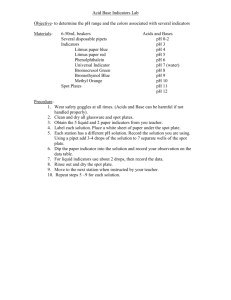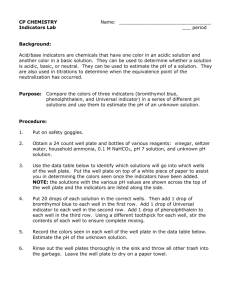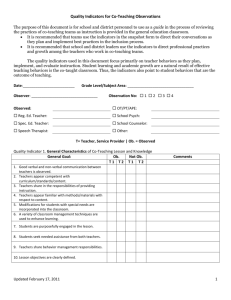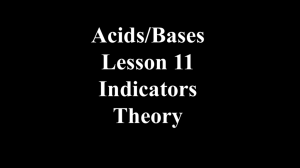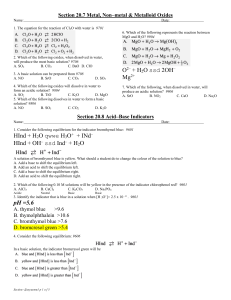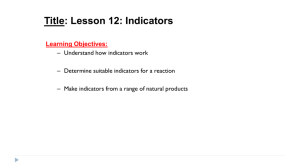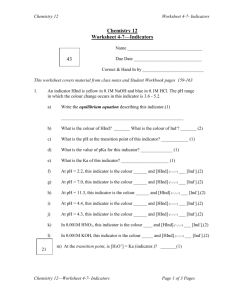Lab handout 1
advertisement
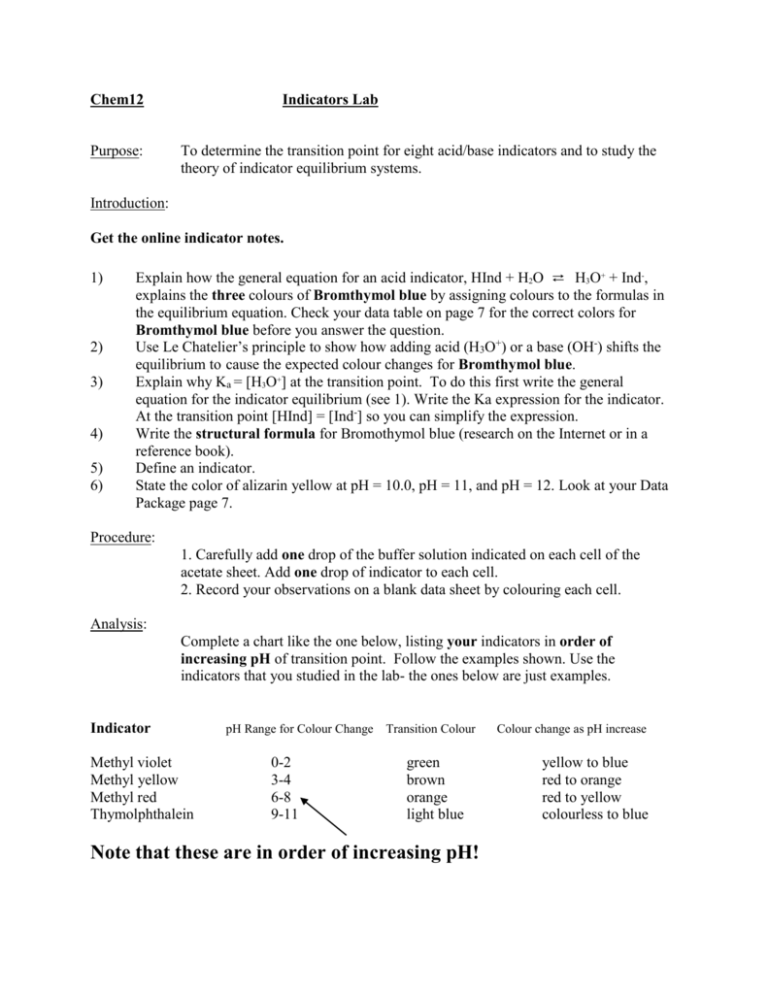
Chem12 Purpose: Indicators Lab To determine the transition point for eight acid/base indicators and to study the theory of indicator equilibrium systems. Introduction: Get the online indicator notes. 1) 2) 3) 4) 5) 6) Explain how the general equation for an acid indicator, HInd + H2O ⇄ H3O+ + Ind-, explains the three colours of Bromthymol blue by assigning colours to the formulas in the equilibrium equation. Check your data table on page 7 for the correct colors for Bromthymol blue before you answer the question. Use Le Chatelier’s principle to show how adding acid (H3O+) or a base (OH-) shifts the equilibrium to cause the expected colour changes for Bromthymol blue. Explain why Ka = [H3O+] at the transition point. To do this first write the general equation for the indicator equilibrium (see 1). Write the Ka expression for the indicator. At the transition point [HInd] = [Ind-] so you can simplify the expression. Write the structural formula for Bromothymol blue (research on the Internet or in a reference book). Define an indicator. State the color of alizarin yellow at pH = 10.0, pH = 11, and pH = 12. Look at your Data Package page 7. Procedure: 1. Carefully add one drop of the buffer solution indicated on each cell of the acetate sheet. Add one drop of indicator to each cell. 2. Record your observations on a blank data sheet by colouring each cell. Analysis: Complete a chart like the one below, listing your indicators in order of increasing pH of transition point. Follow the examples shown. Use the indicators that you studied in the lab- the ones below are just examples. Indicator Methyl violet Methyl yellow Methyl red Thymolphthalein pH Range for Colour Change 0-2 3-4 6-8 9-11 Transition Colour green brown orange light blue Note that these are in order of increasing pH! Colour change as pH increase yellow to blue red to orange red to yellow colourless to blue Also, thymol blue changes colour twice and therefore goes in the chart twice in two different locations! Make your own chart in your lab report with the different indicators used in the lab. Questions: 1. Why does thymol blue change colour twice? (Hint: diprotic indicators have the formula H2Ind). Write two equations and label each reactant and product with its color. H2Ind ⇄ H+ + HInd- HInd- ⇄ H+ + Ind2- 2. Calculate the Ka for bromothymol blue (look at your notes if you don’t know how to do this)! 3. A solution is yellow in thymol blue and red in Methyl Orange. What is the approximate pH of the solution? Describe as a strong or weak acid or base. 4. The Ka for an indicator is approximately 7.9 x10-10. What is the indicator? Look in your notes for examples if you do not know how to do this! 5. A solution is pH: 4.0, 6.0, or 8.0. Describe how you could determine the pH of the solution using the indicators methyl red and bromthymol blue. Make a table and predict each colour for each pH and Indicator. Explain your answer. Conclusion The conclusion should about one-half a page. Describe, what was done in the lab in one sentence. Describe the results- the transition point or points for each indicator. Describe the important components of indicator theory. Be sure to include all the important equations that you are required to know for this course. What are some of the everyday uses for indicators? Use the third person past tense. Describe other significant things that were learned in this lab. Hand in your good copy and not your rough copy. Spell check and grammar check your conclusion.





